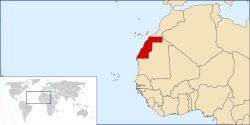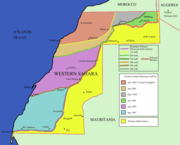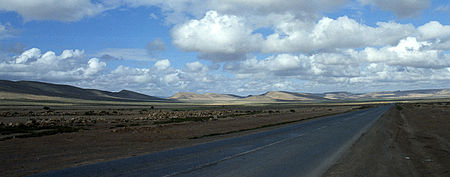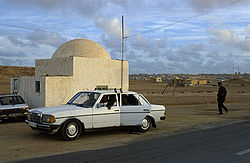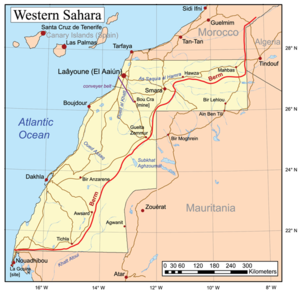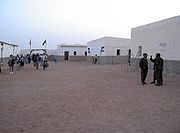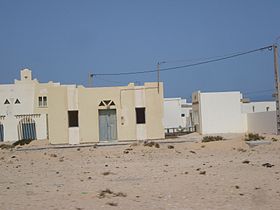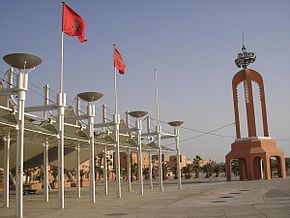
Western Sahara
About this schools Wikipedia selection
This wikipedia selection has been chosen by volunteers helping SOS Children from Wikipedia for this Wikipedia Selection for schools. Click here to find out about child sponsorship.
Coordinates: 25°N 13°W
| The Western Sahara الصحراء الغربية (Arabic)
Taneẓṛuft Tutrimt (Tamazight) Sáhara Occidental (Spanish) |
||
|---|---|---|
|
|
||
| Capital | Laayoune | |
| Largest city | El Aaiún (Laâyoune) | |
| Official languages | Arabic de jure1, Spanish and French widely used, Berber and Hassaniya (locally spoken) |
|
| Demonym | Sahrawi | |
| Disputed sovereignty2 | ||
| - | Relinquished by Spain | November 14, 1975 |
| Area | ||
| - | Total | 266,000 km2 ( 76th) 103,000 sq mi |
| - | Water (%) | negligible |
| Population | ||
| - | 2009 estimate | 513,000 ( 168th) |
| - | Density | 1.9/km2 ( 236th) 5/sq mi |
| Currency | Moroccan dirham, Sahrawi Peseta | |
| Time zone | ( UTC+0) | |
| Calling code | +2123 | |
| ISO 3166 code | EH | |
| Internet TLD | .eh is reserved but not used | |
|
1Arabic is the only official language of both Morocco and the Sahrawi Arab Democratic Republic which claim sovereignty over the territory. 2 Mostly under administration of Morocco as its Southern Provinces. The Polisario Front controls border areas behind the border wall as the Free Zone, on behalf of the Sahrawi Arab Democratic Republic. 3 Code for Morocco; no code specific to Western Sahara has been issued by the ITU. |
||
The Western Sahara (US / ˌ w ɛ s t ər n s ə ˈ h ɛr ə /, UK / ˌ w ɛ s t ər n s ə ˈ h ɑː r ə /; Arabic: الصحراء الغربية, Berber: Taneẓṛuft Tutrimt, Spanish: Sáhara Occidental) is a disputed territory in North Africa, bordered by Morocco to the north, Algeria to the northeast, Mauritania to the east and south, and the Atlantic Ocean to the west. Its surface area amounts to 266,000 square kilometres (103,000 sq mi). It is one of the most sparsely populated territories in the world, mainly consisting of desert flatlands. The population of the territory is estimated at just over 500,000, over half of whom live in El Aaiun, the largest city in Western Sahara (also called Laayoune).
The Western Sahara has been on the United Nations list of non-self-governing territories since 1963 after a Moroccan demand, when it was a Spanish colony. In 1966, the UN called on Spain directly for the first time to decolonize the territory. The Kingdom of Morocco and the Sahrawi national liberation movement Polisario Front, through the Sahrawi Arab Democratic Republic (SADR) (exiled government in Tindouf, Algeria), dispute control of the territory.
Since a United Nations-sponsored ceasefire agreement in 1991, most of the territory (including the entire Atlantic coast line) has been controlled by Morocco, strongly backed by France, and the remainder by the SADR, strongly backed by Algeria. Internationally, major powers such as the United States and Russia have taken a generally ambiguous and neutral position on each side's claims, and have pressed both parties to agree on a peaceful resolution. Both Morocco and POLISARIO have sought to boost their claims by accumulating formal recognition, essentially from African, Asian, and Latin American states in the developing world. The Polisario Front has won formal recognition for SADR from 81 states, and was extended membership in the African Union, while Morocco has won recognition or support for its position from several African governments and from most of the Arab League. In both instances, recognitions have over the past two decades been extended and withdrawn according to changing international trends.
History
Early history
The earliest recorded inhabitants of the Western Sahara were agriculturalists called the Bafour. The Bafour were later replaced or absorbed by Berber-speaking populations which eventually merged in turn with migrating Maqil Arab tribes from Yemen.
The arrival of Islam in the 8th century (although tribal oral traditions mention an earlier date) played a major role in the development of relationships between the Saharan regions that later became the modern territories of Morocco, Western Sahara, Mauritania, and Algeria, and neighbouring regions. Trade developed further, and the region became a highway for caravans, especially between Marrakesh and Tombouctou in Mali. In the Middle Ages, the Berber Almohads and Almoravids empires and dynasties both were able to control the area.
Towards the late Middle Ages, the Maqil Arab bedouin tribes from Yemen invaded the Maghreb, reaching the northern border-area of the Sahara in the 14th and 15th centuries. Over roughly five centuries, through a complex process of acculturation and mixing seen elsewhere in the Maghreb and North Africa, some of the indigenous Berber tribes mixed with the Maqil Arab tribes from Yemen and formed a culture unique to Morocco and Mauritania.
Spanish province
See also: Spanish Sahara and Spanish Morocco
After an agreement among the European colonial powers at the Berlin Conference in 1884 on the division of spheres of influence in Africa, Spain seized control of The Western Sahara and established it as a Spanish colony. After 1939 this area was administered by Spanish Morocco. As a consequence, Ahmed Belbachir Haskouri, the Chief of Cabinet, General Secretary of the Government and Head of the palace for the caliph of Spanish Morocco cooperated with the Spaniards to select governors in that area. The Saharan Lords who were already in prominent positions such as the members of Maa El Ainain family provided a list recommending new governors. Together with the Spanish High Commissioner, Belbachir selected from the list of recommendations. During the prophet's birthday celebration these Lords paid their due respect to the caliph to show loyalty to the Moroccan monarchy. As time went by, Spanish colonial rule began to unravel with the general wave of decolonization after World War II, which saw Europeans lose control of North African and sub-Saharan African possessions and protectorates. Spanish decolonization in particular began rather late, but internal political and social pressures for it in mainland Spain built up towards the end of Francisco Franco's rule, in the context of the global trend towards complete decolonization. Spain began rapidly and even chaotically divesting itself of most of its remaining colonial possessions. After initially being violently opposed to decolonization, Spain began to give in and by 1974–75 issued promises of a referendum on independence.
At the same time, Morocco and Mauritania, which had historical claims of sovereignty over the territory based on competing traditional claims, argued that the territory was artificially separated from their territories by the European colonial powers. The third neighbour of Spanish Sahara, Algeria, viewed these demands with suspicion, influenced also by its long-running rivalry with Morocco. After arguing for a process of decolonization guided by the United Nations, the Algerian government under Houari Boumédiènne committed itself in 1975 to assisting the Polisario Front, which opposed both Moroccan and Mauritanian claims and demanded full independence.
The UN attempted to settle these disputes through a visiting mission in late 1975, as well as a verdict from the International Court of Justice (ICJ), which declared that Western Sahara has historical Links with Morrocco and Mauritania, but population of this territory possessed the right of self-determination. On November 6, 1975 the Green March into Western Sahara began when 350,000 unarmed Moroccans converged on the city of Tarfaya in southern Morocco and waited for a signal from King Hassan II of Morocco to cross the border in a peaceful march. A few days before, on October 31, Moroccan troops invaded The Western Sahara from the North-West of the territory.
Demands for independence
In the waning days of General Franco's rule, and after the Green March the Spanish government signed a tripartite agreement with Morocco and Mauritania as it moved to transfer the Territory on 14 November 1975. Thus the accords foresaw a bipartite administration, Morocco and Mauritania each moved to annex the territories, with Morocco taking control of the northern two-thirds of Western Sahara as its Southern Provinces and Mauritania taking control of the southern third as Tiris al-Gharbiyya. Spain terminated its presence in Spanish Sahara within three months, even repatriating Spanish corpses from its cemeteries. The Moroccan and Mauritanian moves, however, met staunch opposition from the Polisario, which had by now gained backing from Algeria. In 1979, following Mauritania's withdrawal due to pressure from Polisario, including a bombardment of its capital and other economic targets by the Polisario, Morocco extended its control to the rest of the territory, and gradually contained the guerrillas through setting up the extensive sand-berm in the desert (known as the Border Wall or Moroccan Wall) to exclude guerilla fighters. Hostilities ceased in a 1991 cease-fire, overseen by the peacekeeping mission MINURSO, under the terms of a UN Settlement Plan.
Stalling of the referendum and Settlement Plan
The referendum, originally scheduled for 1992, foresaw giving the local population the option between independence or affirming integration with Morocco, but it quickly stalled. In 1997, the Houston Agreement attempted to revive the proposal for a referendum, but likewise has hitherto not had success. As of 2010, however, negotiations over terms have not resulted in any substantive action. At the heart of the dispute lies the question of who qualifies to be registered to participate in the referendum, and, since about 2000, Morocco considers that since there is no agreement on persons entitled to vote, a referendum is not possible,meanwhile Polisario still attached with insistence to the referendum with independence as a clear option, without trying to give a solution to the problem of who is qualified to be registered to participate in the referendum.
Both sides blame each other for the stalling of the referendum. The Polisario has insisted on only allowing those found on the 1974 Spanish Census lists (see below) to vote, while Morocco has insisted that the census was flawed by evasion and sought the inclusion of members of Sahrawi tribes which escape from Spanish invasion to the north of Morocco by the 19th century.
Efforts by the UN special envoys to find a common ground for both parties did not succeed. By 1999 the UN had identified about 85,000 voters, with nearly half of them in the Moroccan-controlled parts of Western Sahara or Southern Morocco, and the others scattered between the Tindouf refugee camps, Mauritania and other places of exile. Polisario accepted this voter list, as it had done with the previous list presented by the UN (both of them originally based on the Spanish census of 1974), but Morocco refused and, as rejected voter candidates began a mass-appeals procedure, insisted that each application be scrutinized individually. This again brought the process to a halt.
According to a NATO delegation, MINURSO election observers stated in 1999, as the deadlock continued, that "if the number of voters does not rise significantly the odds were slightly on the RASD side". By 2001, the process had effectively stalemated and the UN Secretary-General asked the parties for the first time to explore other, third-way solutions. Indeed, shortly after the Houston Agreement (1997), Morocco officially declared that it was "no longer necessary" to include an option of independence on the ballot, offering instead autonomy. Erik Jensen, who played an administrative role in MINURSO, wrote that neither side would agree to a voter registration in which they were destined to lose (see Western Sahara: Anatomy of a Stalemate).
Baker Plan
As personal envoy of the Secretary-General, James Baker visited all sides and produced the document known as the " Baker Plan". This was discussed by the United Nations Security Council in 2000, and envisioned an autonomous Western Sahara Authority (WSA), which would be followed after five years by the referendum. Every person present in the territory would be allowed to vote, regardless of birthplace and with no regard to the Spanish census. It was rejected by both sides, although it was initially derived from a Moroccan proposal. According to Baker's draft, tens of thousands of post-annexation immigrants from Morocco proper (viewed by Polisario as settlers, but by Morocco as legitimate inhabitants of the area) would be granted the vote in the Sahrawi independence referendum, and the ballot would be split three-ways by the inclusion of an unspecified " autonomy", further undermining the independence camp. Also, Morocco was allowed to keep its army in the area and to retain the control over all security issues during both the autonomy years and the election. In 2002, the Moroccan king stated that the referendum idea was "out of date" since it "can not be implemented"; Polisario retorted that that was only because of the King's refusal to allow it to take place.
In 2003, a new version of the plan was made official, with some additions spelling out the powers of the WSA, making it less reliant on Moroccan devolution. It also provided further detail on the referendum process in order to make it harder to stall or subvert. This second draft, commonly known as Baker II, was accepted by the Polisario as a "basis of negotiations" to the surprise of many. This appeared to abandon Polisario's previous position of only negotiating based on the standards of voter identification from 1991 (i.e. the Spanish census). After that, the draft quickly garnered widespread international support, culminating in the UN Security Council's unanimous endorsement of the plan in the summer of 2003.
Today
Baker resigned his post at the United Nations in 2004; his term did not see the crisis resolved. His resignation followed several months of failed attempts to get Morocco to enter into formal negotiations on the plan, but he met with rejection. The new king, Mohammed VI of Morocco, opposes any referendum on independence, and has said Morocco will never agree to one: "We shall not give up one inch of our beloved Sahara, not a grain of its sand".
Instead, he proposes, through an appointed advisory body Royal Advisory Council for Saharan Affairs (CORCAS), a self-governing Western Sahara as an autonomous community within Morocco. His father, Hassan II of Morocco, initially supported the referendum idea in principle in 1982, and in signed contracts with Polisario and the UN in 1991 and 1997; thus engaging to a referendum. However, no major powers have expressed interest in forcing the issue, and Morocco has historically showed little real interest in an actual referendum.
The UN has put forth no replacement strategy after the breakdown of Baker II, and renewed fighting has been raised as a possibility. In 2005, former United Nations Secretary-General Kofi Annan reported increased military activity on both sides of the front and breaches of several cease-fire provisions against strengthening military fortifications.
Morocco has repeatedly tried to get Algeria into bilateral negotiations, based on its view of Polisario as the cat's paw of the Algerian military. It has received vocal support from France and occasionally (and currently) from the United States. These negotiations would define the exact limits of a Western Sahara autonomy under Moroccan rule, but only after Morocco's "inalienable right" to the territory was recognized as a precondition to the talks. The Algerian government has consistently refused, claiming it has neither the will nor the right to negotiate on the behalf of the Polisario Front.
Demonstrations and riots by supporters of independence and/or a referendum broke out in the Moroccan-controlled parts of Western Sahara in May 2005, and in parts of southern Morocco (notably the town of Assa). They were met by police. Several international human rights organizations expressed concern at what they termed abuse by Moroccan security forces, and a number of Sahrawi activists have been jailed. Pro-independence Sahrawi sources, including the Polisario, have given these demonstrations the name " Independence Intifada", while most sources have tended to see the events as being of limited importance. International press and other media coverage has been sparse, and reporting is complicated by the Moroccan government's policy of strictly controlling independent media coverage within the territory.
Demonstrations and protests still occur, after Morocco declared in February 2006 that it was contemplating a plan for devolving a limited variant of autonomy to the territory, but still explicitly refused any referendum on independence. As of January 2007, the plan has not been made public, even if the Moroccan government claims that it has been more or less completed.
Polisario has intermittently threatened to resume fighting, referring to the Moroccan refusal of a referendum as a breach of the cease-fire terms, but most observers seem to consider armed conflict unlikely without the green light from Algeria, which houses the Sahrawis' refugee camps and has been the main military sponsor of the movement.
In April 2007, the government of Morocco suggested that a self-governing entity, through the Royal Advisory Council for Saharan Affairs (CORCAS), should govern the territory with some degree of autonomy for Western Sahara. The project was presented to the UN Security Council in mid-April 2007. The stalemating of the Moroccan proposal options has led the UN in the recent "Report of the UN Secretary-General" to ask the parties to enter into direct and unconditional negotiations to reach a mutually accepted political solution.
In October 2010 Gadaym Izik camp was set up near Laayoune as a protest by displaced Sahrawi people about their living conditions. It was home to more than 12,000 people. In November 2010 Moroccan security forces entered Gadaym Izik camp in the early hours of the morning, using helicopters and water cannon to force people to leave. The Polisario Front said Moroccan security forces had killed a 26-year-old protester at the camp, a claim denied by Morocco. Protesters in Laayoune threw stones at police and set fire to tires and vehicles. Several buildings, including a TV station, were also set on fire. Moroccan officials said five security personnel had been killed in the unrest.
On 15th November 2010, the Moroccan government accused the Algerian secret services of orchestrating and financing the Gadaym Izik camp with the intent to destabilize the region. The Spanish press was accused of mounting a campaign of disinformation to support the Saharwi initiative, and all foreign reporters were either prevented from travelling or else expelled from the area. The protest coincided with a fresh round of negotiations at the UN
Politics
The legal status of the territory and the question of its sovereignty remains unresolved; the territory is contested between Morocco and Polisario Front. It is considered a non self-governed territory by the United Nations.
The government of Morocco is a formally constitutional monarchy under Mohammed VI with a bicameral parliament. The last elections to the lower house were deemed reasonably free and fair by international observers. Certain powers such as the capacity to appoint the government and to dissolve parliament remain in the hands of the monarch. The Morocco-controlled parts of Western Sahara are divided into several provinces treated as integral parts of the kingdom. The Moroccan government heavily subsidizes the Saharan provinces under its control with cut-rate fuel and related subsidies, to appease nationalist dissent and attract immigrants from loyalist Sahrawi and other communities in Morocco proper.
The exiled government of the self-proclaimed Sahrawi Arab Democratic Republic (SADR) is a form of single-party parliamentary and presidential system, but according to its constitution, this will be changed into a multi-party system at the achievement of independence. It is presently based at the Tindouf refugee camps in Algeria, which it controls. It also claims to control the part of Western Sahara to the east of the Moroccan Wall, known as the Free Zone. This area has a very small population, estimated to be approximately 30,000 nomads. The Moroccan government views it as a no-man's land patrolled by UN troops. The SADR government whose troops also patrol the area regard it as the liberated territories and have proclaimed a village in the area, Bir Lehlou as SADR's provisional capital.
Regions
Three Moroccan regions overlap the territory of Western Sahara:
- Guelmim-Es Semara – also includes Moroccan territory outside of Western Sahara
- Laâyoune-Boujdour-Sakia El Hamra
- Oued Ed-Dahab-Lagouira
Morocco controls territory to the west of the berm (border wall) while the Polisario Front controls territory to the east (see map on right).
Dispute
The Western Sahara was partitioned between Morocco and Mauritania in April 1976, with Morocco acquiring the northern two-thirds of the territory. When Mauritania, under pressure from Polisario guerrillas, abandoned all claims to its portion in August 1979, Morocco moved to occupy that sector shortly thereafter and has since asserted administrative control over the whole territory. The official Moroccan government name for Western Sahara is the "Southern Provinces," which indicates Río de Oro and Saguia el-Hamra.
Not under control of the Moroccan government is the area that lies between the border wall and the actual border with Algeria. (for map see external links) The Polisario Front claims to run this as the Free Zone on behalf of the SADR. The area is patrolled by Polisario forces, and access is restricted, even among Sahrawis, due to the harsh climate of the Sahara, the military conflict and the abundance of land mines. Still, the area is traveled and inhabited by many Sahrawi nomads from the Tindouf refugee camps of Algeria and the Sahrawi communities in Mauritania. United Nations MINURSO forces are also present in the area. The UN forces oversee the cease-fire between Polisario and Morocco agreed upon in the 1991 Settlement Plan.
The Polisario forces (of the Sahrawi People's Liberation Army, SPLA) in the area are divided into seven "military regions", each controlled by a top commander reporting to the President of the Polisario proclaimed Sahrawi Arab Democratic Republic. The total size of the Polisario's guerrilla army present in this area is unknown, but it is believed to number a few thousand men, despite many combantants being demobilized due to the cease-fire. These forces are dug into permanent positions, such as gun emplacements, defensive trenches and underground military bases, as well as conducting mobile patrols of the territory.
Major Sahrawi political events, such as Polisario congresses and sessions of the Sahrawi National Council (the SADR parliament in exile) are held in the Free Zone (especially in Tifariti and Bir Lehlou), since it is considered politically and symbolically important to conduct political affairs on Sahrawi territory. In 2005, MINURSO lodged a complaint to the Security Council of the United Nations for "military maneuvers with real fire which extends to restricted areas" by Morocco. A concentration of forces for the commemoration of the Saharawi Republic’s 30th anniversary were however subject to condemnation by the United Nations, as it was considered an example of a cease-fire violation to bring such a large force concentration into the area. In late 2009, Morocco do military maneuvers on Umm Dreiga, in the exclusion zone, violating the cease-fire. Both parties have been accused of such violations by the UN, but to date there has been no serious hostile action from either side since 1991.
Annual demonstrations against the Moroccan Wall are staged in the region by Sahrawis and international activists from Spain, Italy and other mainly European countries. These actions are closely monitored by the UN.
During the joint Moroccan-Mauritanian control of the area, the Mauritanian-controlled part, roughly corresponding to Saquia el-Hamra, was known as Tiris al-Gharbiyya.
Communications
Due to lack of international recognition, the International Telecommunications Union does not assign call sign prefixes for broadcast, experimental or amateur communications. As such, amateur radio operators have adopted SØ as a call sign prefix, rather than one from either of the CNA-CNZ or 5CA-5GZ prefix blocks assigned to Morocco. SØ is unassigned by the ITU. DX-peditions composed of Spanish, Italian, and Russian amateurs have traveled to Tifariti in the Western Sahara desert near the Mauritania border in 2003, 2006, and 2009 operationing as SØ5X, SØ1R, and SØ4R respectively.
Geography
Western Sahara is located in Northern Africa, bordering the North Atlantic Ocean, between Mauritania and Morocco. It also borders Algeria to the northeast. The land is some of the most arid and inhospitable on the planet, but is rich in phosphates in Bou Craa.
Economy
Aside from its rich phosphate deposits and fishing waters, Western Sahara has few natural resources and lacks sufficient rainfall for most agricultural activities. There is speculation that there may be rich off-shore oil and natural gas fields, but the debate persists as to whether these resources can be profitably exploited, and if this would be legally permitted due to the non- decolonized status of Western Sahara (see below).
Western Sahara's economy is centred around nomadic herding, fishing, and phosphate mining. Most food for the urban population is imported. All trade and other economic activities are controlled by the Moroccan government. The government has encouraged citizens to relocate to the territory by giving subsidies and price controls on basic goods. These heavy subsidies have created a state-dominated economy in the Moroccan-controlled parts of Western Sahara, with the Moroccan government as the single biggest employer.
Due to the disputed nature of Moroccan sovereignty over the territory, the application of international accords Western Sahara is highly ambiguous and political leadership of trade agreement signatories such as the United States (US-Morocco Free Trade Agreement) and Norway (European Free Trade Association trade accord) have made statements as to its these agreements non-applicability, although practical policy application is ambiguous.
Demographics
The indigenous population of Western Sahara is known as Sahrawis. These are Hassaniya-speaking tribes of mixed Arab–Berber heritage, effectively continuations of the tribal groupings of Hassaniya speaking Moorish tribes extending south into Mauritania and north into Morocco as well as east into Algeria. The Sahrawis are traditionally nomadic bedouins, and can be found in all surrounding countries. War and conflict has led to major displacements of the population.
As of July 2004, an estimated 267,405 people (excluding the Moroccan army of some 160,000) lived in the Moroccan-controlled parts of Western Sahara. Many people from parts of Morocco outside of the Southern Provinces have come to live in the area, and these latest arrivals are today thought to outnumber the indigenous Western Sahara Sahrawis. The precise size and composition of the population is subject to political controversy.
The Polisario-controlled parts of Western Sahara are barren. This area has a very small population, estimated to be approximately 30,000 in 2008. The population is primarily made up of nomads who engage in herding camels back and forth between the Tindouf area and Mauritania. However, the presence of mines scattered throughout the territory by the Moroccan army makes it a dangerous way of life.
The Spanish census and MINURSO
A 1974 Spanish census claimed there were some 74,000 Sahrawis in the area at the time (in addition to approximately 20,000 Spanish residents), but this number is likely to be on the low side, due to the difficulty in counting a nomad people, even if Sahrawis were by the mid-1970s mostly urbanized. Despite these possible inaccuracies, Morocco and the Polisario Front agreed on using the Spanish census as the basis for voter registration when striking a cease-fire agreement in the late 1980s, contingent on the holding of a referendum on independence or integration into Morocco.
In December 1999 the United Nations' MINURSO mission announced that it had identified 86,425 eligible voters for the referendum that was supposed to be held under the 1991 Settlement plan and the 1997 Houston accords. By "eligible voter" the UN referred to any Sahrawi over 18 years of age that was part of the Spanish census or could prove his/her descent from someone who was. These 86,425 Sahrawis were dispersed between Moroccan-controlled Western Sahara and the refugee camps in Algeria, with smaller numbers in Mauritania and other places of exile. These numbers cover only Sahrawis 'indigenous' to the Western Sahara during the Spanish colonial period, not the total number of "ethnic" Sahrawis (i.e., members of Sahrawi tribal groupings), who also extend into Mauritania, Morocco and Algeria. The number was highly politically significant due to the expected organization of a referendum on self-determination.
The Polisario has its home base in the Tindouf refugee camps in Algeria, and declares the number of Sahrawi population in the camps to be approximately 155,000. Morocco disputes this number, saying it is exaggerated for political reasons and for attracting more foreign aid. The UN uses a number of 90,000 "most vulnerable" refugees as basis for its food aid program.
Culture
The major ethnic group of the Western Sahara are the Sahrawis, a nomadic or Bedouin tribal or ethnic group speaking the Hassānīya dialect of Arabic, also spoken in much of Mauritania. They are of mixed Arab-Berber descent, but claim descent from the Beni Hassan, a Yemeni tribe supposed to have migrated across the desert in the 11th century.
Physically indistinguishable from the Hassaniya speaking Moors of Mauritania, the Sahrawi people differ from their neighbors partly due to different tribal affiliations (as tribal confederations cut across present modern boundaries) and partly as a consequence of their exposure to Spanish colonial domination. Surrounding territories were generally under French colonial rule.
Like other neighboring Saharan Bedouin and Hassaniya groups, the Sahrawis are Muslims of the Sunni sect and the Maliki fiqh. Local religious custom ( 'urf) is, like other Saharan groups, heavily influenced by pre-Islamic Berber and African practices, and differs substantially from urban practices. For example, Sahrawi Islam has traditionally functioned without mosques in the normal sense of the word, in an adaptation to nomadic life.
The originally clan- and tribe-based society underwent a massive social upheaval in 1975, when a part of the population was forced into exile by the Polisario and settled in the refugee camps of Tindouf, Algeria, where they remain sequestrated till now. Families were broken up by the dispute. For developments among this population, see Sahrawi and Tindouf Province.
